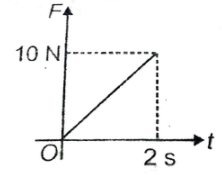If a body of mass 5 kg initially at rest is acted upon by a force of 50 dyne for 3s, then the impulse will be
0.98×10−3Ns
1.5×10−3Ns
2×10−3Ns
2.5×10−3Ns
The correct Answer is:B
To solve the problem, we need to calculate the impulse experienced by a body of mass 5 kg when a force of 50 dyne acts on it for 3 seconds. Here’s the step-by-step solution:
Step 1: Understand the concept of impulse
Impulse is defined as the product of force and the time duration for which the force acts. Mathematically, it can be expressed as:
Impulse=Force×Time
Step 2: Convert the force from dyne to newton
The force given is 50 dyne. We need to convert this value into newtons. The conversion factor is:
1 dyne=10−5 newton
Thus,
Force=50 dyne=50×10−5 newton=5×10−4 newton
Step 3: Identify the time duration
The time duration for which the force acts is given as 3 seconds.
Step 4: Substitute the values into the impulse formula
Now we can substitute the values of force and time into the impulse formula:
Impulse=Force×Time
Impulse=(5×10−4 N)×(3 s)
Step 5: Calculate the impulse
Now, performing the multiplication:
Impulse=15×10−4 N⋅s=1.5×10−3 N⋅s
Conclusion
The impulse experienced by the body is:
Impulse=1.5×10−3 N⋅s
Final Answer
The correct option is 1.5×10−3 N⋅s.
---
Impulse is defined as the product of force and the time duration for which the force acts. Mathematically, it can be expressed as:
Impulse=Force×Time
The force given is 50 dyne. We need to convert this value into newtons. The conversion factor is:
1 dyne=10−5 newton
Thus,
Force=50 dyne=50×10−5 newton=5×10−4 newton
The time duration for which the force acts is given as 3 seconds.
Now we can substitute the values of force and time into the impulse formula:
Impulse=Force×Time
Impulse=(5×10−4 N)×(3 s)
Now, performing the multiplication:
Impulse=15×10−4 N⋅s=1.5×10−3 N⋅s
The impulse experienced by the body is:
Impulse=1.5×10−3 N⋅s
The correct option is 1.5×10−3 N⋅s.
Topper's Solved these Questions
- LAWS OF MOTIONBOOK - DC PANDEY ENGLISHCHAPTER - LAWS OF MOTIONEXERCISE - Match the columns
7 Videos
- KINEMATICS 1BOOK - DC PANDEY ENGLISHCHAPTER - KINEMATICS 1EXERCISE - INTEGER_TYPE
15 Videos
- LAWS OF THERMODYNAMICSBOOK - DC PANDEY ENGLISHCHAPTER - LAWS OF THERMODYNAMICSEXERCISE - Level 2 Subjective
18 Videos
Similar Questions
A body of mass 500 g, initially at rest, is acted upon by a force which causes it to move a distance of 4 m in 2 s, Calculate the force applied.
View SolutionA body of mass 5 kg initially at rest is subjected to a force of 20 N. What is the kinetic energy acquired by the body at the end of 10 s?
View SolutionA body of mass 2.0 kg initially at rest is moved by a horizontal force of 0.50 N on a smooth table. Find the work done by the force in 8.0 s and show that this equals the change in the kinetic energy of the body.
View SolutionA body of mass 5kg initially at rest, is subjected to a force of 40 N. Find the kinetic energy acquired by the body at the end of 5 seconds :
View SolutionA body is acted upon by balanced forces
View SolutionA force given by the relation F=8t, acts on a body of mass 2kg, initialiy at rest. Find the work done by this force on the body during first 2 seconds of its motion.
View SolutionA time varying force F=6t−2t2N, at t=0 starts acting on a body of mass 2kg initially at rest, where t is in second. The force is withdrawn just at the instant when the body comes to rest again. We can see that at t=0 the force F=0. Now answer the following:
Find the duration for which the force acts on the body.
View SolutionA force acts for 0.1 s on a body of mass 1.2 kg initially at rest. The force then ceases to act and the body moves thorugh 2 m in the next 1.0 s . Find the magnitude of force.
View SolutionA body of mass 20 kg is kept initially at rest. A force of 80 N is applied on the body then the acceleration produced in the body is 3m/s2, force of friction acting on the body is :
View SolutionA variable force acts on a body of mass 2 kg intially at rest as shown in figure . Calculate the impulse of the force in first 2 seconds and speed of the body after 2 seconds .

View Solution